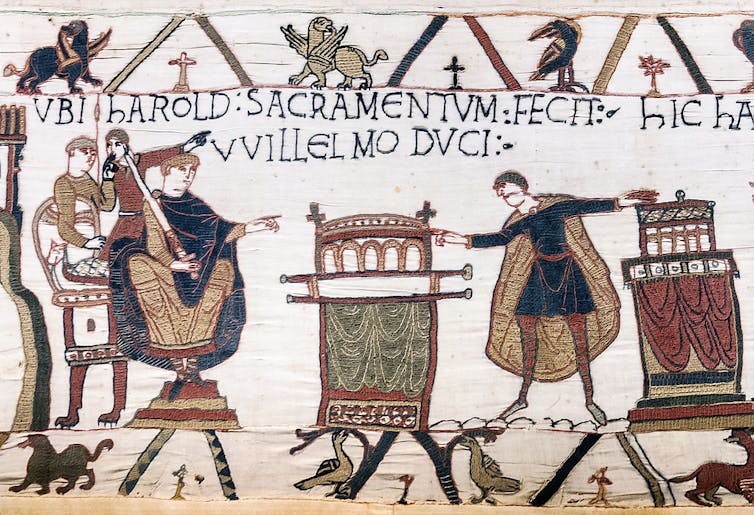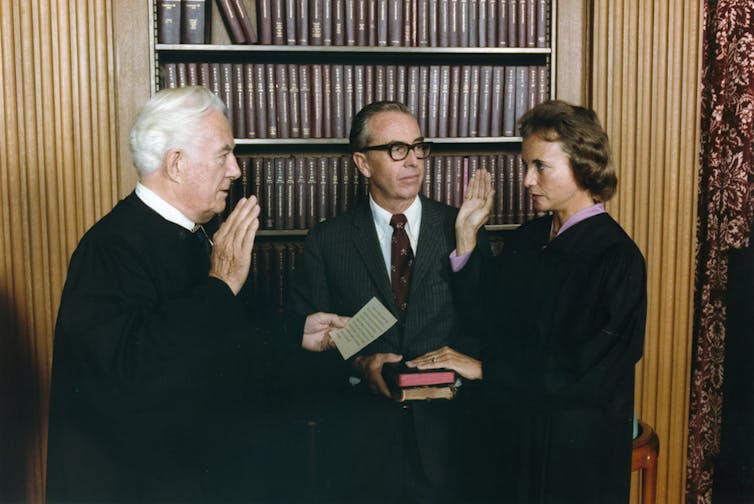The history of oath ceremonies and why they matter when taking office
- Written by Joanne M. Pierce, Professor of Religious Studies, College of the Holy Cross
The confirmation hearings for[1] Amy Coney Barrett have drawn much[2] notice for her religious worldview.
Barrett’s alleged commitment[3] to a small Christian religious group, People of Praise, has raised concerns. This covenant[4] is a formal pledge to remain a member for life, following its authority structures, religious beliefs and expectations for service or charitable activities.
Barrett must take an oath – both governmental and judicial – swearing impartiality if she is approved for the post of a Supreme Court justice. Some commentators have questioned[5] this apparent permanent commitment to an ultraconservative “fringe” group and whether that might interfere with her ability to genuinely practice this impartiality[6].
As a scholar of medieval Christian liturgy and ritual[7], I believe this is a moment to understand why oaths are so important, as well as how they came to be such an important tradition.
What is an oath?
Some philosophers[8] and anthropologists[9] define an oath as a ritual act[10], or more specifically a “speech act[11].”
An oath is one kind of speech act. Taking an oath expresses a specific intention to others, using words like “I promise to” or “I swear that.” The intention when taking an oath is not limited to the moment someone articulates the words of the oath.
Oath-taking is also about the intention in the future to commit to act in a certain way. One example is the vows taken by couples during their wedding in front of witnesses.
British philosopher John L. Austin[12] called oaths[13] “performative utterances.”[14] The engaged couple, for example, declare their act of marrying each other by speaking their vows to each other. They make a deliberate choice of their own free will.
Roman soldiers and allegiance
The ritual of taking oaths goes back centuries in Western Europe.
In antiquity, oaths were often demanded of religious and governmental leaders, as well as those in certain professions. In ancient Rome, oaths were also demanded of soldiers.
The most solemn military oath – directly invoking the Roman gods – was the “sacramentum[15].” By this oath, soldiers swore allegiance to their specific general or commanding consul and, later, to the emperor. Disobedience could earn severe punishments[16].
 A tapestry scene showing swearing oath on holy relics to William, Duke of Normandy.
Myrabella via Wikimedia Commons[17]
A tapestry scene showing swearing oath on holy relics to William, Duke of Normandy.
Myrabella via Wikimedia Commons[17]
On some occasions, oath-breaking was tested by resorting to divine intervention. The virgin goddess Vesta was one of the most important in Roman religion. Her priestesses, the Vestals, or Vestal Virgins[18], therefore took an oath of chastity for their 30-year term of service tending to the ever-burning sacred fire of Rome, Vesta’s sacred hearth, as well as other rites.
Vestals accused of breaking that oath were judged by the high priest of Rome. Since a priestess was a sacred person, her blood could not be shed. If found guilty, the priestess was buried alive, with a lamp and a little food, and left to the judgment of Vesta. If any condemned Vestal were innocent, it was believed that surely the goddess would manifest[19] her innocence by being freed her from her living death.
Oaths in the Middle Ages
In medieval Europe, Christians continued to take oaths. The religious and secular worlds were closely interconnected for most of these centuries, and most oaths referred to Christian beliefs.
In the early Middle Ages, Christians took oaths[20] in the name of God, often while holding a religious object like a relic of a saint[21] or a book of the Gospels.
In most cases, oaths were not strictly person to person, but involved the wider community in some important way. Kings took coronation oaths[22], swearing to rule justly and safeguard the people of the kingdom; lesser nobles took oaths of fealty[23] to greater nobles, often for protection and material advantage.
Religious leaders like bishops and abbots also became part of this oath-based system, since they, too, had secular jurisdiction over important tracts of land. Breaking an oath was believed to bring down the wrath of God in time, but other than that, upholding one’s personal honor and reputation within the local community was a key consideration.
Until the early 13th century, Christian rites would accompany[24] the earlier Germanic practice of trial by ordeal. In these earlier centuries, most local people accused of a crime could be found not guilty by compurgation – that is, through oaths made by other respected members of the community testifying to the accused’s honest character[25].
In other cases, often involving strangers to the local community, the accused could be cleared only by a divine intervention.
After a night of fasting and prayer, the accused would undergo a physical ordeal, like carrying a heated block of iron over a set number of steps or by being thrown into a pond to sink or float.
If the accused did not develop blisters or was “accepted” by the water and sank, that was understood as God’s declaration of his innocence. As time went on, scholars and ordinary people increasingly criticized the reliability of trials[26] by ordeal.
By the 13th century, the procedures of the court trial were defined and adopted, both in canon law – that is, the church law – and in secular law.
Why oaths matter
When drafting the U.S. Constitution in 1787, the Founding Fathers rejected some of the legal practices of the British system of law. One such rejection was of the “religious test[27].”
In Great Britain, all office holders had to affirm the religious doctrines of the Church of England. But in the independent United States, there was to be no such religious restriction placed on federal officeholders. Preserving religious liberty was a primary concern protected by the Constitution.
One of the British legal practices the Founding Fathers did include in the Constitution was the swearing of oaths upon entering federal governmental service. However, these oaths were not taken to pledge loyalty to a single monarch, but to “protect and defend” the Constitution itself.
 Sandra Day O'Connor being sworn in as a Supreme Court justice by Chief Justice Warren Burger in September 1981.
Series: Reagan White House Photographs, 1/20/1981 - 1/20/1989 Collection: White House Photographic Collection, 1/20/1981 - 1/20/1989[28]
Sandra Day O'Connor being sworn in as a Supreme Court justice by Chief Justice Warren Burger in September 1981.
Series: Reagan White House Photographs, 1/20/1981 - 1/20/1989 Collection: White House Photographic Collection, 1/20/1981 - 1/20/1989[28]
But “swearing-in ceremonies” communicate far more. Supreme Court justices take two oaths[29], one judicial, and the other constitutional. The oath ceremony is still a serious performative utterance.
The appointees take these oaths in front of witnesses, who are themselves representative of the entire community the appointees will serve.
Appointees to the Supreme Court commit themselves[30], not to a partisan political agenda, and not to a cult of personality or to the judgment of popular opinion. They commit themselves to “protect and defend the Constitution” and “administer justice without respect to persons … faithfully and impartially.”
[Deep knowledge, daily. Sign up for The Conversation’s newsletter[31].]
Justices might be impeached by Congress[32] for failing in “good behavior.” But in practice, justices serve for life, until death or retirement, and are bound in good conscience to carry out their “duties” as they have sworn to do.
The conscience of appointees, not the preservation of their personal reputations, has been the focus of these “oaths of office” for almost 250 years. This is as true today as it was in 1787.
References
- ^ confirmation hearings for (www.cnn.com)
- ^ drawn much (www.deseret.com)
- ^ alleged commitment (peopleofpraise.org)
- ^ covenant (dictionary.cambridge.org)
- ^ Some commentators have questioned (apnews.com)
- ^ genuinely practice this impartiality (slate.com)
- ^ scholar of medieval Christian liturgy and ritual (www.holycross.edu)
- ^ Some philosophers (www.thoughtco.com)
- ^ anthropologists (books.google.com)
- ^ ritual act (plato.stanford.edu)
- ^ speech act (www.thoughtco.com)
- ^ John L. Austin (www.philosophypages.com)
- ^ called oaths (semantics.uchicago.edu)
- ^ performative utterances.” (www.glottopedia.org)
- ^ sacramentum (oxfordre.com)
- ^ severe punishments (www.google.com)
- ^ Myrabella via Wikimedia Commons (upload.wikimedia.org)
- ^ the Vestals, or Vestal Virgins (digitalcommons.wou.edu)
- ^ goddess would manifest (digitalcommons.wou.edu)
- ^ took oaths (www.google.com)
- ^ relic of a saint (sourcebooks.fordham.edu)
- ^ coronation oaths (www.bl.uk)
- ^ oaths of fealty (www.google.com)
- ^ accompany (repository.law.umich.edu)
- ^ testifying to the accused’s honest character (www.google.com)
- ^ criticized the reliability of trials (books.google.com)
- ^ religious test (constitutioncenter.org)
- ^ Series: Reagan White House Photographs, 1/20/1981 - 1/20/1989 Collection: White House Photographic Collection, 1/20/1981 - 1/20/1989 (catalog.archives.gov)
- ^ take two oaths (www.supremecourt.gov)
- ^ commit themselves (www.supremecourt.gov)
- ^ Sign up for The Conversation’s newsletter (theconversation.com)
- ^ impeached by Congress (constitution.congress.gov)
Authors: Joanne M. Pierce, Professor of Religious Studies, College of the Holy Cross

